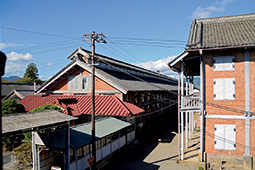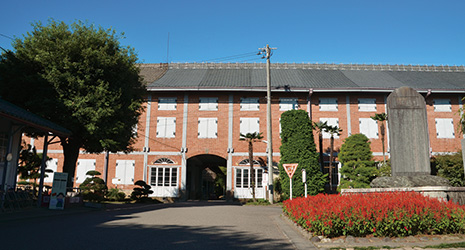

Exterior and interior of the silk-reeling plant 
A close-up of the brickwork 
The glass multi-purpose hall inside the West Cocoon Warehouse
- PREVIOUS
- NEXT
December 2020
Tomioka Silk Mill: A Model for Modernization

Tomioka Silk Mill, a World Heritage site and National Treasure, stands as a memorial to a turning point in Japan’s industrial history.

When Japan re-opened for international trade in the middle of the nineteenth century after more than 250 years of national seclusion, silkworm eggs and raw silk thread* were in high demand overseas, and these raw materials soon came to account for more than 80% of Japan’s exports. The new Meiji government, established in 1868, paid attention to this trade and began efforts toward mass production of reeled silk thread. To achieve this, government leaders imported silk-reeling expertise and machines from France, and in 1872 constructed Tomioka Silk Mill on a site covering about 53,000 m2 in present-day Tomioka City, Gunma Prefecture as a government-operated model silk mill. The working mill comprised two 100-meter-long cocoon warehouses, a cocoon drying facility, a silk-reeling plant, a steam boiler plant, an iron water tank and a brick drain. Situated nearby were houses, dormitories and a clinic for the foreign experts and employees.

The cocoon warehouses and silk-reeling plant share the same timber-framed brick structure as that used for the “Yokosuka Ironworks” in present-day Kanagawa Prefecture, which was built at the end of Edo period (1603–1867) with technical help from the French Navy. The bricks were baked by Japanese tile artisans under the guidance of French technicians, and there is a beautiful harmony in these buildings between the roof of Japanese tiles and the red brick walls. The ceiling of the huge silk-reeling plant, which is 140 meters long, is supported by triangular roof trusses, creating an open space capable of accommodating various machines and hundreds of workers. The walls of the building are lined with large iron-framed windows imported from France and designed to let in lots of light and ventilation. The houses and dormitories built for the French experts and instructors are also timber-framed brick structures and likewise remain standing to this day.
In 1893, Tomioka Silk Mill was sold to the private sector. The mill was operative until 1987 when the last of a number of owners, the present-day Katakura Industries Co., Ltd., finally closed it following the decline of the domestic silk industry owing to the increased use of imported raw silk thread and synthetic fibers. Katakura Industries, which had continued to manage and maintain the site, donated the buildings to Tomioka City in 2005, and the city administration opened them up to the public in the same year.

In 2014, “Tomioka Silk Mill and Related Sites” was inscribed on UNESCO’s World Heritage List. In the same year, the mill’s two cocoon warehouses and silk-reeling plant were designated as a National Treasure of Japan.
Tomioka City has duly developed a preservation and management plan, and a thirty-year maintenance and utilization plan, for these historic sites.

The first major project was the work to preserve the West Cocoon Warehouse that started in 2015. Conservation work was completed in 2020 and the building was opened to the public in October. The timber-frame structure and brick walls were more or less left intact, and about 60% of the roof tiles were also reused, while necessary repairs and reinforcements were made to preserve the building alongside preparations for its utilization. The plaster on the interior walls and ceiling of the first floor was also left in its original state as a way of conveying the mill’s history and value, although it has degraded over time and stains and cracks are evident.

In a unique initiative for a National Treasure, on the first floor of the West Cocoon Warehouse an exhibition room and multi-purpose hall has been installed making use of iron frames for aseismic reinforcement. The ceiling and walls of this “house within a house” are made of glass so that visitors can clearly see the walls and ceiling of the National Treasure building from inside the installed room.
Japan became the world-leading exporter of raw silk thread in the early twentieth century. Innovation in Japanese silk-reeling technology turned the world’s silk goods from something precious and expensive to something more familiar. The writings of workers left on the walls of the West Cocoon Warehouse communicate the real-time atmosphere of life in the silk industry that drove Japanese modernization. Such traces are another precious face of the World Heritage site that is the Tomioka Silk Mill.
* Raw silk thread is a natural fiber made from the cocoons of silkworms. “Silk reeling” refers to the process of drawing silk thread from the cocoons, combining several of them, and making raw silk thread suitable for processing.
- PREVIOUS
- NEXT

